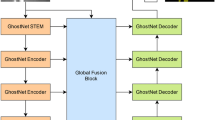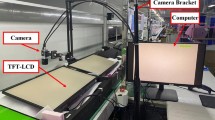Abstract
Real-time detection of surface defects in high-generation, large-size Liquid Crystal Display (LCD) panels is a serious challenge for both image algorithms and processing speed. For the defect detection of Thin Film Transistor-Liquid Crystal Display (TFT-LCD) images, effectively processing the periodic texture composed of gate lines and data lines is a prerequisite for the success of the algorithm. The traditional one-dimensional Fourier reconstruction algorithm uses a filter-based method to remove most of the texture, but due to the spectral leakage problem, the image boundary cannot be effectively processed. The compensation based on the period extension introduces a more complex ringing effect at the image connection. Starting from the implicit periodic principle of Fourier transform, we propose a strategy of complete period truncation based on subpixel period, which completely eliminates the boundary texture. Furthermore, we fully exploit the potential of parallel execution of the algorithm, resampling the liquid crystal segments truncated in the complete period to an integer power length of 2. The FPGA structure of one-dimensional Fourier reconstruction defect segmentation algorithm with dual-task parallelism and two-pixel parallelism is designed and the calculation bandwidth of 500 MB/s can be realized at 125-MHz clock frequency. We demonstrate the superiority of the proposed method qualitatively and quantitatively. The one-dimensional Fourier reconstruction algorithm based on the complete period truncation can effectively detect various defects such as spots, scratches, fibers and dirt, and the false-positive rate of defects has been reduced by half. The resampling-based Fourier transform speeds up the computational process and the FPGA parallel acceleration architecture is three times faster than comparable server CPUs, reducing the scan detection time of the entire 8.5-generation LCD panel to 8.5 s.













Similar content being viewed by others
Notes
The fast Fourier transform IP core was provided by Silicon Software GmbH.
References
Pratt, W.K., Hawthorne, J.A.: Machine vision methods for automatic defect detection in liquid crystal displays. Adv. Imaging 13, 52–54 (1998)
Ko, J., Rheem, J.: Defect detection of polycrystalline solar wafers using local binary mean. Int. J. Adv. Manuf. Technol. 82(9), 1753–1764 (2016)
Zhu, Z., Qian, X., Zhao, Q., Zhou, Q., Ni, K., Wang, X.: TFT-LCD uneven brightness correction and recognition of MURA area based on EMD method. In: 2016 International Conference on Audio, Language and Image Processing (ICALIP), 11–12 July 2016, pp. 366–369
Nguyen, V.H., Pham, V.H., Cui, X., Ma, M., Kim, H.: Design and evaluation of features and classifiers for OLED panel defect recognition in machine vision. J. Inf. Telecommun. 1(4), 334–350 (2017)
Mak, K.L., Peng, P., Yiu, K.F.C.: Fabric defect detection using morphological filters. Image Vis. Comput. 27(10), 1585–1592 (2009)
Luo, Q., He, Y.: A cost-effective and automatic surface defect inspection system for hot-rolled flat steel. Robot. Comput. Manuf. 38, 16–30 (2016)
Smith, M.L., Stamp, R.J.: Automated inspection of textured ceramic tiles. Comput. Ind. 43(1), 73–82 (2000)
Tsai, D.-M., Wu, S.-C., Li, W.-C.: Defect detection of solar cells in electroluminescence images using Fourier image reconstruction. Sol. Energy Mater. Sol. Cells 99, 250–262 (2012)
Sindagi, V.A., Srivastava, S.: Domain adaptation for automatic OLED panel defect detection using adaptive support vector data description. Int. J. Comput. Vis. 122(2), 193–211 (2017)
Haraclick, R.M.: Texture features for image classification. IEEE Trans. SMC 6, 610–621 (1973)
Tsai, D.M., Chuang, S.T.: 1D-based defect detection in patterned TFT-LCD panels using characteristic fractal dimension and correlations. Mach. Vis. Appl. 20(6), 423–434 (2009)
Mei, S., Yang, H., Yin, Z.: Unsupervised-learning-based feature-level fusion method for mura defect recognition. IEEE Trans. Semicond. Manuf. 30(1), 105–113 (2017)
Ren, R., Hung, T., Tan, K.C.: A generic deep-learning-based approach for automated surface inspection. IEEE Trans. Cybern. 48(3), 929–940 (2018)
Lu, C.-H., Tsai, D.-M.: Independent component analysis-based defect detection in patterned liquid crystal display surfaces. Image Vis. Comput. 26(7), 955–970 (2008)
Cen, Y.-G., Zhao, R.-Z., Cen, L.-H., Cui, L.-H., Miao, Z.-J., Wei, Z.: Defect inspection for TFT-LCD images based on the low-rank matrix reconstruction. Neurocomputing 149, 1206–1215 (2015)
Alex, K., Sutskever, I., Hinton, G.E.: ImageNet classification with deep convolutional neural networks. In: Pereira, F., Burges, C.J.C., Bottou, L., Weinberger, K.Q. (eds.) Advances in Neural Information Processing Systems 25, pp. 1097–1105. Curran Associates, Inc., New York (2012)
Perng, D.-B., Chen, S.-H.: Directional textures auto-inspection using discrete cosine transform. Int. J. Prod. Res. 49(23), 7171–7187 (2011)
Wang, F.-L., Zuo, B.: Detection of surface cutting defect on magnet using Fourier image reconstruction. J Cent. South Univ. 23(5), 1123–1131 (2016)
Yeh, C., Wu, F., Ji, W., Huang, C.: A wavelet-based approach in detecting visual defects on semiconductor wafer dies. IEEE Trans. Semicond. Manuf. 23(2), 284–292 (2010)
Tsai, D.M., Hung, C.Y.: Automatic defect inspection of patterned thin film transistor-liquid crystal display (TFT-LCD) panels using one-dimensional Fourier reconstruction and wavelet decomposition. Int. J. Prod. Res. 43(21), 4589–4607 (2005)
Tsai, D.M., Chuang, S.T., Tseng, Y.H.: One-dimensional-based automatic defect inspection of multiple patterned TFT-LCD panels using Fourier image reconstruction. Int. J. Prod. Res. 45(6), 1297–1321 (2007)
Zhang, T., Lu, R.: Automatic period selection for DFT method in the application of TFT-LCD panel detection. J. Electron. Meas. Instrum. 30(3), 361–373 (2016)
Zhang, T., Lu, R., Dang, X.: Automatic neighbor r selection for one-dimensional DFT method in the surface defect inspection of TFT-LCD. China Mech. Eng. 27(21), 2895–2901 (2016)
Donald, G.B.: Design for Embedded Image Processing on FPGAs. Publishing House of Electronics Industry, Beijing (2013)
Matteo F., Steven G.J.: FFTW. http://www.fftw.org/ (2018). Accessed 29 Apr 2019
Funding
This work was supported by the National Key Research and Development Program of China (No. 2018YFB2003801), the National Natural Science Foundation of China (NSFC) (Grant no. 51875164) and the National Key Scientific Instrument and Equipment Development Project of China (No. 2013YQ220749).
Author information
Authors and Affiliations
Corresponding author
Additional information
Publisher's Note
Springer Nature remains neutral with regard to jurisdictional claims in published maps and institutional affiliations.
Rights and permissions
About this article
Cite this article
Pan, Y., Lu, R. & Zhang, T. FPGA-accelerated textured surface defect segmentation based on complete period Fourier reconstruction. J Real-Time Image Proc 17, 1659–1673 (2020). https://doi.org/10.1007/s11554-019-00927-1
Received:
Accepted:
Published:
Issue Date:
DOI: https://doi.org/10.1007/s11554-019-00927-1




